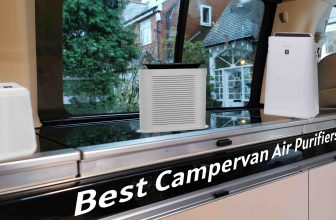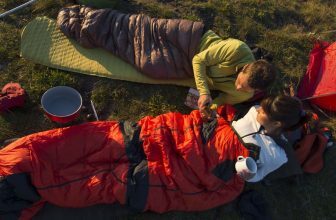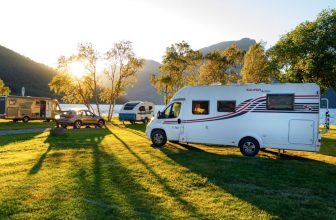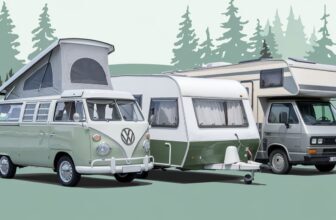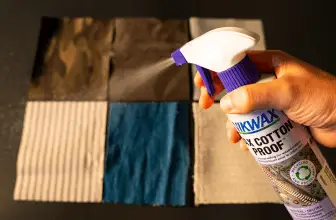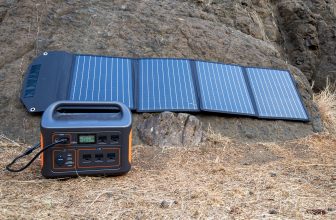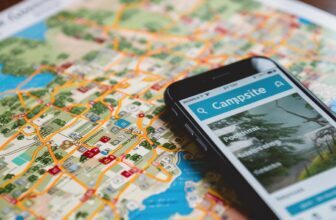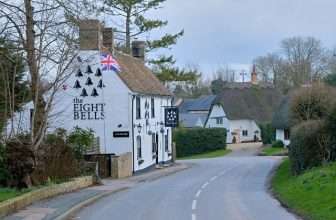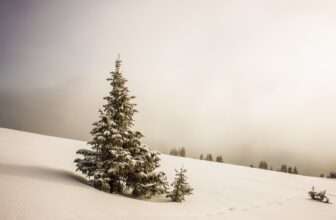
When you’re miles from civilization, perched on a mountaintop with a breathtaking view, the last thing you expect to complicate your trip is boiling water. But at high altitudes, the simple task of heating water for your morning coffee or preparing a meal becomes a science experiment in itself. Ever wonder why your water seems to boil faster, yet your food takes forever to cook? The answer lies in the physics of altitude and air pressure—a surprising twist that every camper should understand before venturing into the mountains.
At higher elevations, air pressure decreases, and this has a direct impact on the boiling point of water. You might notice that your water reaches a rolling boil quicker, but your meals take much longer to cook. The science behind this seemingly strange phenomenon is fascinating, and understanding it can be the difference between an efficient camping trip and a frustrating one.
In this post, we’ll explore how altitude impacts water boiling in your camping kettle and why it matters for your cooking, hydration, and safety when camping at high altitudes. So, whether you’re planning a trek in the Rockies or camping in the Himalayas, you’ll have the knowledge you need to handle your campsite kitchen like a pro.
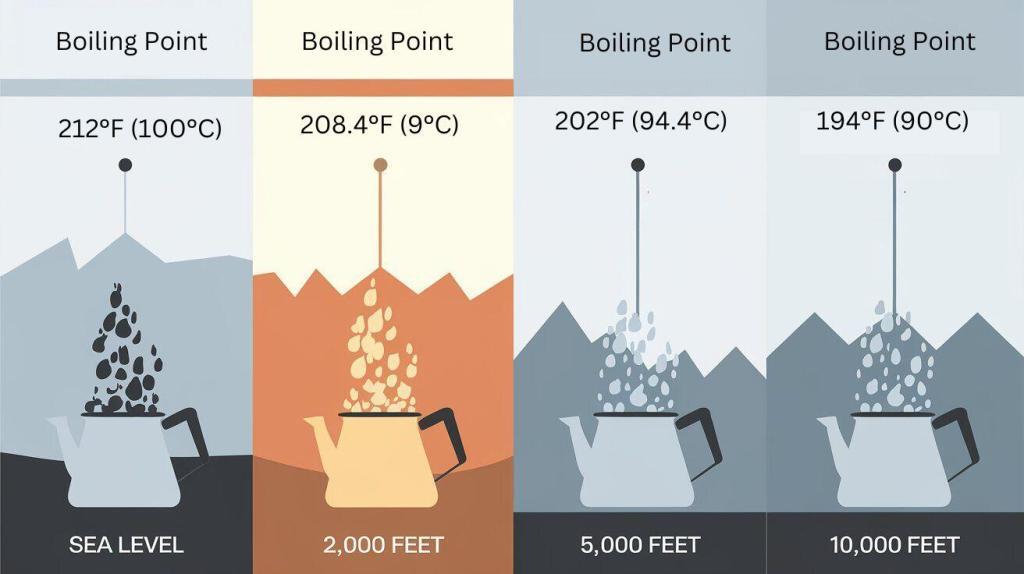
Contents
ToggleWhat Happens When You Boil Water at High Altitudes?
When you ascend to higher altitudes, the air around you starts to behave differently. One of the key changes is the drop in atmospheric pressure. At sea level, air pressure is at its highest, and it plays an important role in how water behaves when heated. To understand why boiling water is affected at high altitudes, let’s dive into some basic science.
How Air Pressure Affects Boiling
At sea level, water boils at 212°F (100°C) because the surrounding atmospheric pressure is strong enough to keep the water molecules in liquid form until they reach that temperature. Boiling occurs when the vapor pressure of water equals the surrounding atmospheric pressure, allowing water molecules to escape into the air as steam.
However, as you climb in elevation, the air pressure around you decreases. This means the water needs less energy to turn into steam, causing it to boil at a lower temperature. For instance, at 5,000 feet above sea level, water boils at about 203°F (95°C), and at 10,000 feet, it boils around 194°F (90°C). While the water may appear to boil as usual, it’s not as hot as it would be at sea level.
Impact on Cooking and Water Purification
This change in boiling point can throw off your entire cooking routine. Since the water boils at a lower temperature, food takes longer to cook. Simmering a stew or boiling pasta might require more patience than usual, as the lower heat requires extra time to break down ingredients. If you don’t account for this, you might end up with undercooked meals, which can be frustrating after a long day of hiking.
The reduced boiling temperature also impacts water purification. Typically, boiling water for a few minutes is enough to kill harmful bacteria and pathogens, but at higher elevations, the lower boiling point means the water may not reach a temperature high enough to purify it effectively. To ensure safety, you’ll need to boil the water for a longer time or use additional purification methods.
How Altitude Affects Water Boiling
As you climb higher, the boiling point of water decreases, which can have a significant impact on your cooking and water purification when camping. To fully grasp how altitude affects your trusty camping kettle, let’s take a closer look at the numbers and how they translate to real-world scenarios.
Boiling Point Changes at Different Altitudes
The relationship between altitude and the boiling point of water is well documented. As you ascend, the air pressure drops, and with it, the temperature at which water boils. Here’s a quick guide to how the boiling point changes at different elevations:
- Sea Level (0 feet): Water boils at 212°F (100°C).
- 2,000 feet (610 meters): Water boils at around 208°F (98°C).
- 5,000 feet (1,524 meters): Water boils at around 203°F (95°C).
- 10,000 feet (3,048 meters): Water boils at around 194°F (90°C).
- 14,000 feet (4,267 meters): Water boils at around 185°F (85°C).
These temperature changes might not seem drastic at first glance, but they can make a big difference when you’re cooking or purifying water. For example, at 10,000 feet, water boils at almost 20°F lower than at sea level. That’s enough to slow down cooking times significantly and may affect how thoroughly food is cooked or how safely water is purified.
Temperature Differences and Cooking
At higher altitudes, the lower boiling point means your food is being cooked at a lower temperature, which results in slower cooking times. Whether you’re boiling water for pasta, preparing dehydrated meals, or simmering a stew, you’ll need to adjust your expectations and timing. What might take 10 minutes to cook at sea level could take 15-20 minutes at higher altitudes. Foods like rice, beans, and pasta are particularly affected since they require sustained boiling.
For campers who are used to preparing meals quickly, this can come as a surprise. The trick is to keep your kettle on the heat longer and allow for extra cooking time. You may also need to use more fuel, so plan accordingly.
Boiling Water for Safe Drinking
When it comes to purifying water, the lower boiling point can pose a safety risk if not accounted for. Boiling water is one of the most effective ways to kill harmful bacteria, viruses, and parasites, but at high altitudes, the water may not get hot enough to ensure complete purification.
At sea level, boiling water for 1-3 minutes is typically sufficient to make it safe for drinking. However, at elevations above 6,500 feet, you should extend the boiling time to at least 3-5 minutes to compensate for the lower temperature. Alternatively, you can combine boiling with other methods, like using a water filter or purification tablets, to ensure that the water is safe.
By understanding how altitude affects the boiling point, you can make the necessary adjustments to both your cooking and water safety practices, ensuring a successful and safe camping experience in the mountains.
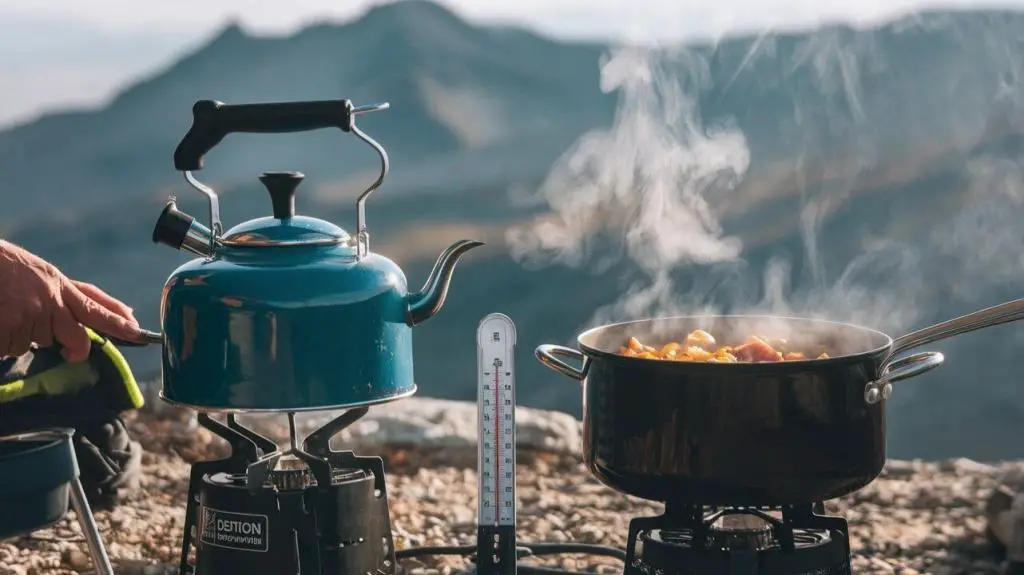
Practical Tips for Using a Camping Kettle at High Altitudes
Understanding the science behind boiling water at high altitudes is only half the battle. To ensure that your camping experience goes smoothly, here are some practical tips for using your camping kettle effectively in the mountains, where lower air pressure changes the game.
1. Adjust Cooking Times
Since water boils at a lower temperature at higher altitudes, it takes longer to cook your meals. Here are a few ways to adapt:
- Increase Cooking Times: Plan to cook your meals for at least 20-30% longer than you would at sea level. Foods that require boiling, like pasta, rice, or hard vegetables, will take extra time to become tender.
- Pre-soak Foods: For ingredients like beans, rice, or grains, consider pre-soaking them to reduce cooking time. This can also conserve fuel, which is precious during multi-day camping trips.
- Use a Lid: Always cover your kettle or pot while boiling water to trap heat and speed up cooking time.
2. Boil Water Longer for Purification
At high altitudes, water boils at lower temperatures, so you need to boil it for longer to ensure it’s safe to drink:
- Extended Boiling Time: If you’re camping above 6,500 feet, boil water for at least 3-5 minutes. This ensures that it reaches a temperature high enough for sufficient purification. At very high altitudes, err on the side of caution and boil for closer to 5 minutes.
- Combining Methods: For extra safety, use a multi-step purification process. Boil the water first and then filter it or add purification tablets to kill any lingering microorganisms.
3. Fuel Conservation Tips
At higher elevations, you may need more fuel to compensate for longer cooking and boiling times:
- Pack Extra Fuel: Whether you’re using a gas stove or a multi-fuel burner, always pack extra fuel. Cooking at high altitudes can consume more than you expect due to extended boiling and simmering times.
- Use Efficient Kettles and Stoves: If possible, bring camping gear designed to be fuel-efficient, like kettles with heat-exchanger technology or insulated cooking systems. These can significantly reduce fuel consumption by boiling water faster and retaining heat better.
4. Pre-trip Preparation
Knowing the altitude of your camping destination can help you prepare better:
- Research Elevation: Before your trip, find out the elevation of your campsite or planned hiking route. This will give you a rough idea of how much the boiling point of water will drop and how to adjust your cooking and water purification strategies.
- Bring a Thermometer: If you’re going on a technical expedition or are concerned about precision, bringing a small thermometer can help you track the exact temperature of the boiling water, giving you more control over your cooking and water purification efforts.
5. Slow-Cooking Solutions
If your trip allows for it, consider bringing food that benefits from slow cooking at lower temperatures:
- Dehydrated Meals: Many dehydrated camping meals are designed to rehydrate with boiling water. While they’ll still take a little longer to prepare at high altitudes, they can be a convenient solution for minimizing cooking time.
- Use Thermal Cooking: Another option is to use insulated containers for slow cooking. After bringing water to a boil, you can place your kettle in an insulated sleeve to continue cooking your meal slowly, conserving fuel in the process.
6. Stay Patient and Flexible
One of the most important tips for cooking at high altitudes is simply to be patient:
- Mentally Prepare for Delays: You may face delays in cooking times or other minor challenges, but staying flexible and giving yourself extra time to prepare meals or boil water will prevent frustration.
By following these practical tips, you’ll be well-prepared to handle the challenges of high-altitude cooking and water purification, making the most out of your camping kettle no matter where your adventure takes you.
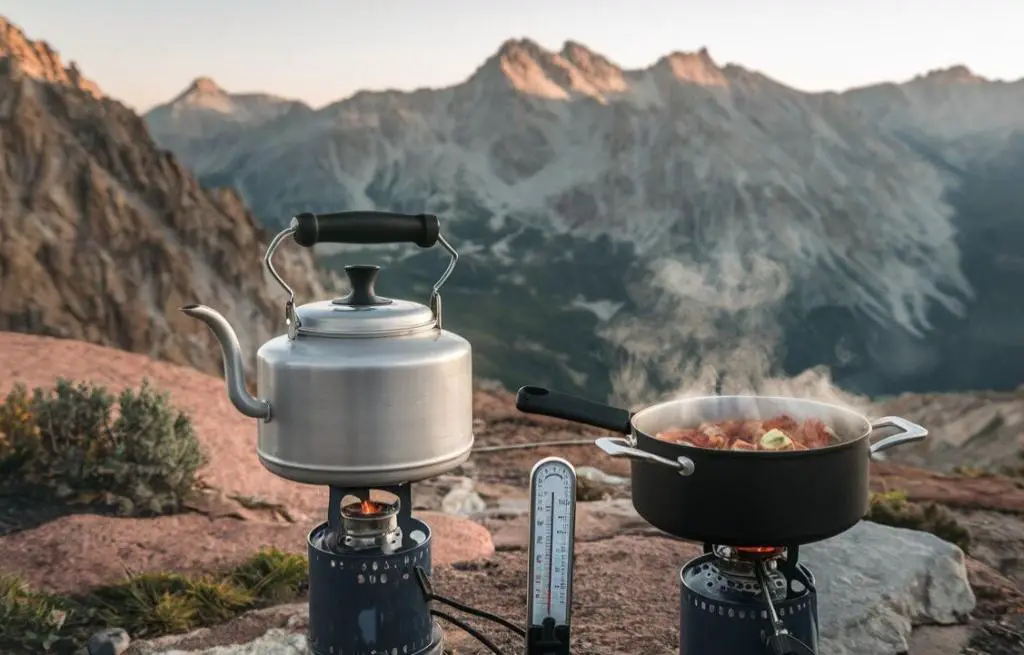
Common Mistakes to Avoid
Even with a solid understanding of how altitude affects boiling water, there are a few common mistakes that campers make when using their camping kettle at higher elevations. Avoid these pitfalls to ensure your trip runs smoothly and safely.
1. Underestimating Cooking Time
One of the most frequent mistakes campers make is assuming that water boiling at a lower temperature is still hot enough to cook food in the usual time. At high altitudes, food will take longer to cook due to the lower boiling point of water. If you don’t adjust your cooking times, you could end up with undercooked meals, which can be both unpleasant and, in some cases, unsafe.
- Avoiding the Mistake: Always plan for longer cooking times at high altitudes, especially for dishes like pasta, rice, or anything that requires simmering. If your food seems to be cooking too slowly, resist the urge to add more heat—let it take its time, and add fuel if necessary.
2. Rushing Water Purification
Another critical mistake is not allowing enough time to properly purify water by boiling it. Since water boils at a lower temperature at high altitudes, it may not reach a temperature hot enough to kill all harmful microorganisms unless boiled for a longer period. Some campers mistakenly think that as soon as the water reaches a boil, it’s safe to drink, but at high altitudes, that’s not always the case.
- Avoiding the Mistake: Be sure to boil water for at least 3-5 minutes at elevations above 6,500 feet, or longer if you’re camping at extreme heights. Alternatively, consider using additional water purification methods, like filters or tablets, in combination with boiling to ensure safety.
3. Not Packing Enough Fuel
The extended cooking and boiling times at high altitudes require more fuel (e.g. butane or propane) than you might anticipate. Many campers pack the same amount of fuel they would use at lower elevations, only to find that they run out halfway through their trip.
- Avoiding the Mistake: Always pack extra fuel if you’re heading to high elevations. The longer cooking times, coupled with the need to boil water for purification, can quickly deplete your fuel supply. A good rule of thumb is to carry 20-30% more fuel than you would need at sea level.
4. Ignoring Altitude-Specific Preparations
Some campers head to high altitudes without fully understanding how much the altitude will affect their cooking and boiling. This can lead to unpleasant surprises, such as meals that aren’t ready when expected or a shortage of drinkable water.
- Avoiding the Mistake: Do your research before heading to high-altitude destinations. Know the elevation of your campsite and plan accordingly. You can also check for weather conditions, as cold temperatures combined with high altitude can affect how efficiently your camping stove and kettle perform.
5. Not Using a Lid
A simple but overlooked mistake is boiling water or cooking food without a lid on the kettle or pot. Without a lid, heat escapes quickly in the thinner air, leading to longer boiling and cooking times, which in turn uses up more fuel.
- Avoiding the Mistake: Always use a lid when boiling water or cooking food at high altitudes. This traps heat, helping water boil faster and keeping cooking times more manageable.
By avoiding these common mistakes, you can ensure that your high-altitude camping experience is both safe and enjoyable. Proper preparation and small adjustments in your routine can make a big difference when it comes to cooking and staying hydrated in the mountains.
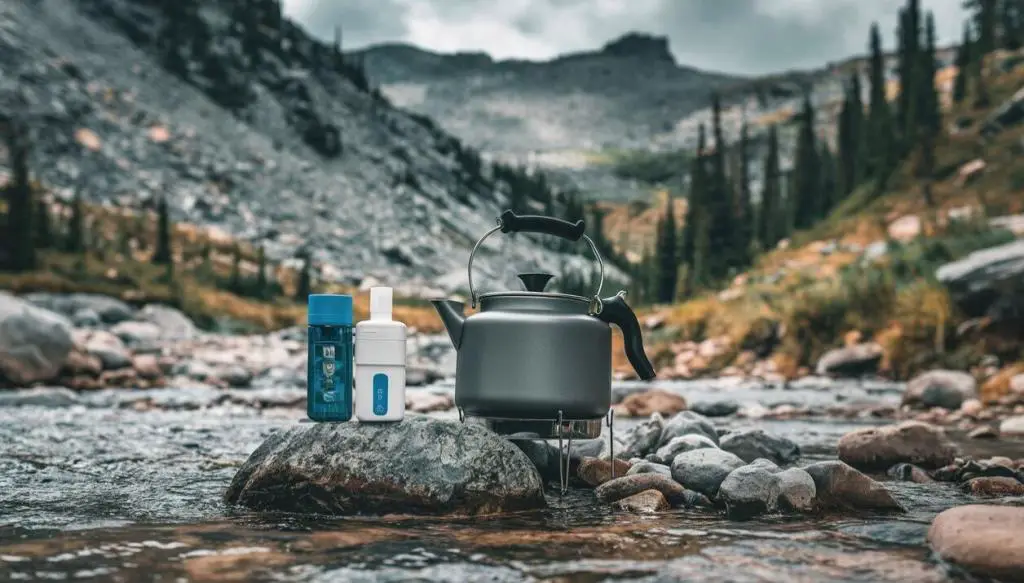
Conclusion
Camping at high altitudes introduces a unique set of challenges, but understanding how altitude affects boiling water can turn these obstacles into manageable parts of your adventure. From the science of air pressure to practical tips for cooking and water purification, the key is to prepare, adjust, and remain flexible.
The lower boiling point of water at higher elevations means that cooking times will be longer, and purifying water requires extra care. By extending cooking times, boiling water for longer, and ensuring you pack enough fuel, you’ll be ready to face the unpredictable nature of mountain camping. Avoid common mistakes, like underestimating boiling times or not packing extra fuel, and you’ll be able to navigate high-altitude camping with ease.
In the end, understanding the science behind these changes doesn’t just make your trip more enjoyable — it keeps you safe. Whether you’re scaling the Rockies or trekking through the Himalayas, these small adjustments will ensure your meals are hot and your water is safe to drink, making your high-altitude adventures a success.
So next time you pack your camping kettle, remember: altitude matters. With the right knowledge and preparation, you can enjoy the experience without the frustrations, and focus on the breathtaking views and unforgettable moments that come with mountain camping.
